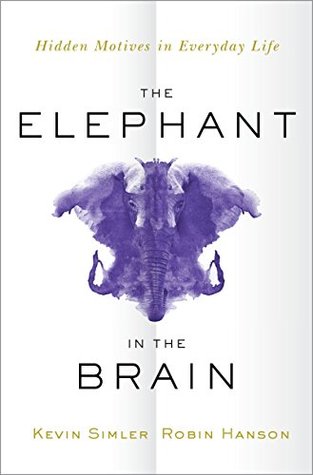More on this book
Community
Kindle Notes & Highlights
by
Kevin Simler
Read between
June 13 - July 28, 2020
Our brains are built to act in our self-interest while at the same time trying hard not to appear selfish in front of other people. And in order to throw them off the trail, our brains often keep “us,” our conscious minds, in the dark. The less we know of our own ugly motives, the easier it is to hide them from others.
So throughout the book, we’ll be using “the elephant” to refer not just to human selfishness, but to a whole cluster of related concepts: the fact that we’re competitive social animals fighting for power, status, and sex; the fact that we’re sometimes willing to lie and cheat to get ahead; the fact that we hide some of our motives—and that we do so in order to mislead others.
the demand for luxury goods is driven largely by a social motive: flaunting one’s wealth.
social brain hypothesis, or sometimes the Machiavellian intelligence hypothesis.3 It’s the idea that our ancestors got smart primarily in order to compete against each other in a variety of social and political scenarios.
many of our most distinctive behaviors serve reproductive rather than survival ends.
Frans de Waal published his influential book Chimpanzee Politics,
Just as the redwoods are competing for light from the sun, we’re competing for the “light” of attention and affection from potential mates, friends, and allies.
The problem with words is that they cost almost nothing; talk is usually too cheap.
As we think about our own ancestry and how we were shaped by it, it pays to keep the redwoods in mind. Faced with intense intra-species competition, they literally rose to the occasion, out of the darkness and into the light. So too with many of our most exaggerated features.
Everybody cheats.
Their conclusion is that we, humans, must self-deceive. Those who refuse to play such mind games will be at a game-theoretic disadvantage relative to others who play along. Thus we are often wise to ignore seemingly critical information and to believe easily refuted falsehoods—and then to prominently advertise our distorted thinking—because these are winning moves.
Wear a mask long enough and it becomes your face.26 Play a role long enough and it becomes who you are. Spend enough time pretending something is true and you might as well believe it.
it’s not our intentions that determine whether a norm was violated, but our knowledge.
In summary, our minds are built to sabotage information in order to come out ahead in social games.
how suggestible people are to packaging, presentation, brand, and other framing effects.
“Tragedy,” said Mel Brooks, “is when I cut my finger. Comedy is when you walk into an open sewer and die.”
As Oscar Wilde said,54 “If you want to tell people the truth, make them laugh; otherwise they’ll kill you.”
“The man who reads nothing at all is better educated than the man who reads nothing but newspapers.”—Thomas Jefferson (attributed)32
we’re stuck in a rat race.
No matter how fast the economy grows, there remains a limited supply of sex and social status—and earning and spending money is still a good way to compete for it.3
One way or another, we’re all conspicuous consumers.
What they found is that, when subjects are primed with a status motive, they show a stronger preference for green products when shopping in public,
In part, this is because we typically assume that ads are targeting us directly, as individual buyers; indirect influence can be harder to see.
When BMW advertises during popular TV shows or in mass-circulation magazines, only a small fraction of the audience can actually afford a BMW. But the goal is to reinforce for non-buyers the idea that BMW is a luxury brand. To accomplish all this, BMW needs to advertise in media whose audience includes both rich and poor alike, so that the rich can see that the poor are being trained to appreciate BMW as a status symbol.
Our disdain for replicas strongly suggests that we often use art as something other than a trigger for sensory or intellectual experiences.
we do charity in part because of a selfish psychological motive: it makes us happy.
One study found that when door-to-door solicitors ask for donations, people give more when there are two solicitors than when there’s just one.22 But even when it’s a lone solicitor, people donate significantly more when the solicitor makes eye contact with them.
very few people give more than they’ll be recognized for.
In other words, charity is an advertisement, a way of showing off.
In other words, the value of education isn’t just about learning; it’s also about credentialing. Of course, this idea is much older than Spence; he’s just famous for expressing the idea in math.
it’s not the knowledge itself that’s as important as showing that you have the generic ability to learn and complete schoolwork.
the extra school helps distinguish you as a better worker.
A partial (but unsatisfying) answer is that going to school is simply the norm, and therefore anyone who deviates from it shows their unwillingness to conform to societal expectations.
patients who receive more medicine don’t achieve better health outcomes.
those who exercised a lot lived 15 years longer than those who exercised only a little.
Religion. There’s perhaps no better illustration of the elephant in the brain.
7. 47Gregory


